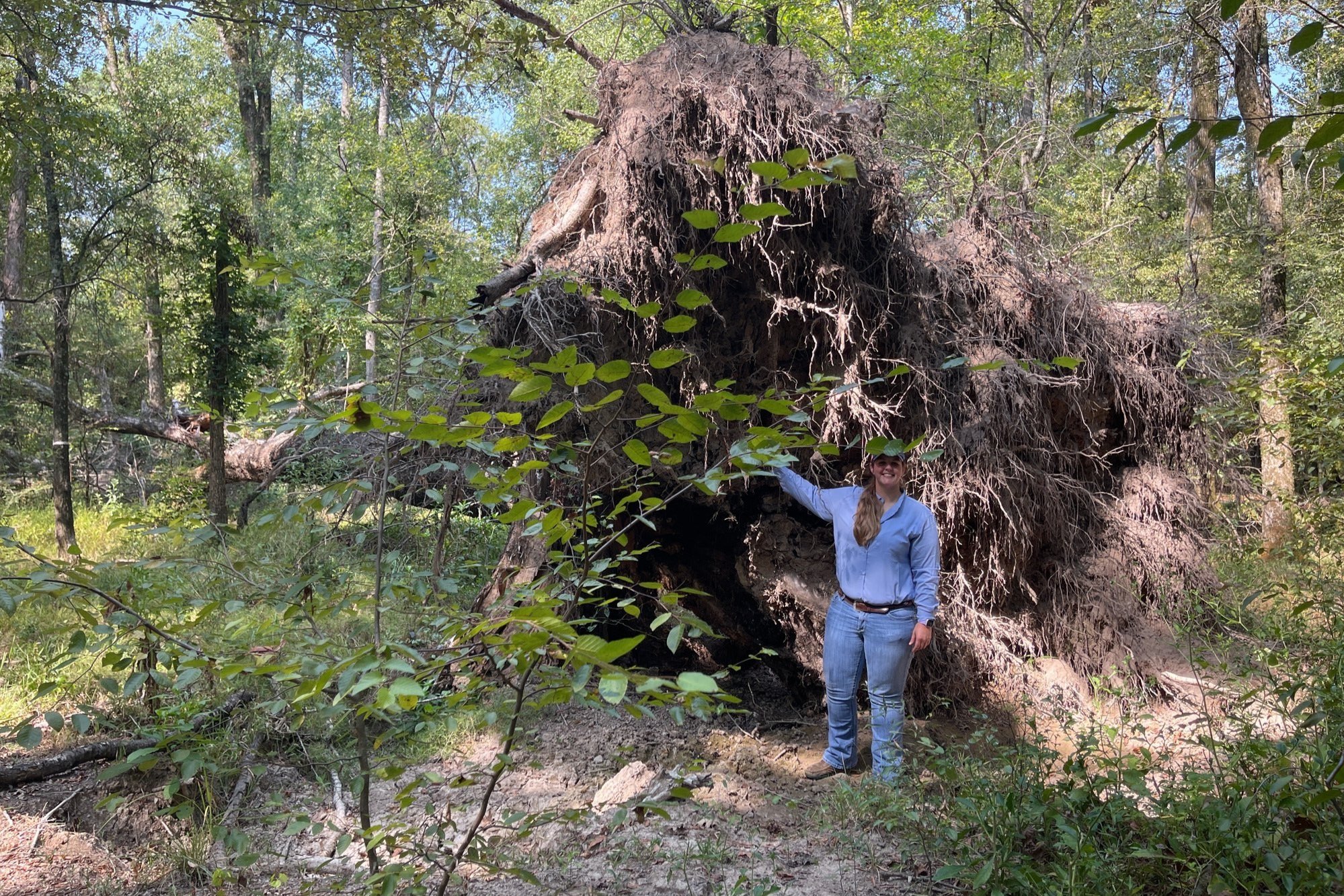Dead Trees Provide New Life
A fallen tree featuring Jamie Hooker
Between floods, hurricanes, ice storms, windstorms, and tornadoes, East Texas is no stranger to extreme weather throughout the year. Heavy rains and high winds affected large portions of the region from early spring through mid-summer this year. Trying to schedule monitoring visits with our landowners has been a huge hurdle between high waters and damage from downed trees. While it may be disheartening to see the beautiful old oaks and the tall pines fall, there are some ecological benefits.
Downed Trees
Although losing a tree that has most likely been on a property longer than its landowner can be upsetting, know that those fallen giants now serve a new purpose within their ecosystem. Downed trees provide homes and food sources for many animals, plants, and fungi. Reptiles, small mammals, and birds use the elevated surface of a log as a “lookout” spot to search for food and watch for predators. Ground nesting birds, deer, coyotes, and bobcats often bed down against logs or build nests within the brambles of lying branches. Amphibians and reptiles will wedge between the bark and wood of the tree to create thermal cover and a place to stay concealed during brumation. Overturned roots serve as nesting grounds for birds and cover for small mammals such as mice and rabbits. As the tree decomposes, squirrels will bury their most prized foods under the rotten wood to keep hidden from other animals. Fungi, moss, and lichens grow along downed trees as well, creating more habitat and food for insects.
Shelf Fungus taken by Stephen Ramirez
Snags
Standing dead trees, known as snags, serve several important purposes within forests, open savannahs, and prairies. Insects such as moths, beetles, and ants forage on the dead tree and on the fungi and lichen that also grow on them. Woodpeckers and nuthatches excavate cavities along the trunk of the snag for nesting. These cavities also provide nests for other birds (bluebirds, flycatchers, swallows, owls) and mammals (raccoons, opossums, and squirrels) that cannot create a cavity on their own. Loose bark and lightning scars make great roosting sites for bats. Louisiana black bears will also use larger, hollowed out snags as dens along the Texas-Louisiana river corridors.
Left photo taken by Cathryn McDonough, right photo taken by Jamie Hooker
Canopy Openings
Closed canopy forests offer little on the ground as far as wildlife habitat is concerned. Typically, dark and littered with leaves and pine needles, these types of forests have hardly any herbaceous plants, grasses, shrubs, or smaller trees available to serve as food and cover for wildlife. Once an opening in the canopy occurs due to fallen trees, a gap is made, and sunlight can reach the forest floor. Early successional plants will establish in these gaps, providing food and cover for wildlife. Multiple canopy gaps spread across several acres create diversity on the landscape and increase the amount of wildlife your property can support.
Forest canopy take by Stephen Ramirez
Soil Health
As fallen trees decompose, they release nutrients back into the very thing that allowed them to topple: the soil. Decomposing trees contribute to the organic matter that makes up the top layer of soil. Organic matter is extremely important in filtering water that moves through the forest before it enters into nearby streams, rivers, and lakes. Carbon stored within the once photosynthesizing tree is also released back into the soil, along with other nutrients such as nitrogen, calcium, and magnesium. Just as with humans, nutrients are key for new plant growth, productivity, and reproductive cycle.
Pine tree leaves behind a standing sheet of bark after falling at a TLC protected property in Nacogdoches County taken by Jamie Hooker
Although it can be devastating to lose a large, old tree, we need to remember that they have other ecological purposes to fill once they’ve died. Next time you see a snag or downed tree, I encourage you to sit and watch to see who is benefiting from the tree’s loss. You might be surprised by the life that surrounds these dead trees and may not fear the next predicted thunderstorm, hurricane, flood, or wind event.






